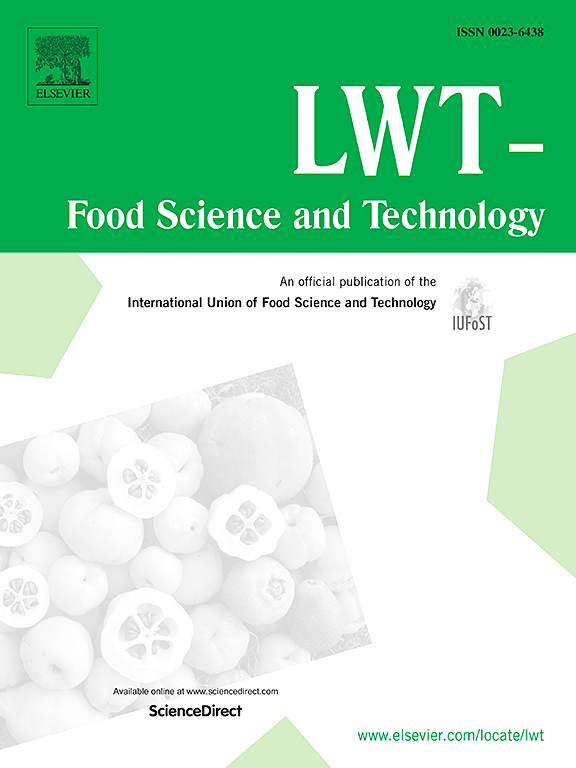用普洱茶提取的多糖共轭物稳定乳液的理化特性及其对姜黄素的保护作用
IF 6
1区 农林科学
Q1 FOOD SCIENCE & TECHNOLOGY
引用次数: 0
摘要
本研究旨在通过结构分析和宏观表征,研究不同储存期对普洱茶中多糖-蛋白复合物(pTPC)乳化性能的影响,并进一步探讨pTPC稳定纳米乳液在不同环境条件下的稳定性。通过测定化学成分、界面张力和红外光谱发现,与 pTPC-13 相比,pTPC-18 氨基酸含量更高,导致分子内多糖与茶多酚之间的氢键和静电作用增强,从而提高了其吸附率和界面膜厚度。此外,pTPC-18 稳定化纳米乳液的稳定性表明,在 0-90 天的储存期、pH 值为 2.0-9.0、25-100 °C、Na+ 和 Ca2+ 的条件下,zeta 电位和粒度没有发生显著变化,而 pTPC-13 稳定化乳液在相同的应力条件下表现出明显的液滴聚集和分层不稳定性。此外,与 pTPC-13 纳米乳液(39%)相比,pTPC-18 纳米乳液(60%)在姜黄素包囊方面表现出更强的姜黄素保护能力。这些结果表明,在长期储存过程中,pTPC-18 中蛋白质和多酚含量的相对增加增强了其乳化特性,为脂质活性物质递送系统的开发提供了新的思路。本文章由计算机程序翻译,如有差异,请以英文原文为准。

Physicochemical characterization of emulsions stabilized with polysaccharide conjugates extracted from Pu'er tea and their protective effect on curcumin
This study aimed to investigate the influence of different storage periods on the emulsifying properties of polysaccharide-protein complexes (pTPC) in Pu 'er tea through structural analysis and macroscopic characterization, and further explore the stability of pTPC-stabilized nano-emulsions in various environmental conditions. Through determination of chemical composition, interfacial tension, and infrared spectroscopy, it was found that compared to pTPC-13, the higher amino acid content of pTPC-18 led to enhanced hydrogen bonding and electrostatic interactions between intramolecular polysaccharides and polyphenols, thereby increasing its adsorption rate and interfacial film thickness. Additionally, the stability of pTPC-18 stabilized nano-emulsions showed no significant changes in zeta potential and particle size over 0–90 days of storage, pH 2.0–9.0, 25–100 °C, Na+ and Ca2+, whereas pTPC-13 stabilized emulsions exhibited noticeable droplet aggregation and layering instability under the same stress conditions. Furthermore, for curcumin encapsulation, pTPC-18 nano-emulsions (60%) demonstrated stronger protection of curcumin compared to pTPC-13 nano-emulsions (39%). These results suggest that during long-term storage, the relative increase in protein and polyphenol content within pTPC-18 enhances its emulsifying properties, providing new insights into the development of lipid-active substance delivery systems.
求助全文
通过发布文献求助,成功后即可免费获取论文全文。
去求助
来源期刊

LWT - Food Science and Technology
工程技术-食品科技
CiteScore
11.80
自引率
6.70%
发文量
1724
审稿时长
65 days
期刊介绍:
LWT - Food Science and Technology is an international journal that publishes innovative papers in the fields of food chemistry, biochemistry, microbiology, technology and nutrition. The work described should be innovative either in the approach or in the methods used. The significance of the results either for the science community or for the food industry must also be specified. Contributions written in English are welcomed in the form of review articles, short reviews, research papers, and research notes. Papers featuring animal trials and cell cultures are outside the scope of the journal and will not be considered for publication.
 求助内容:
求助内容: 应助结果提醒方式:
应助结果提醒方式:


